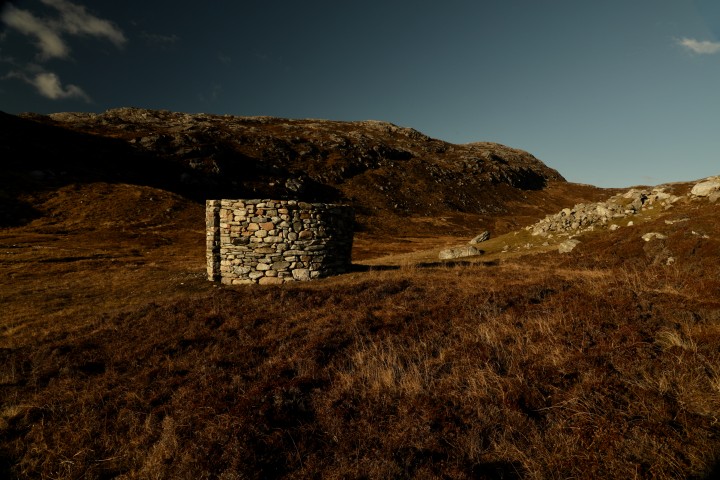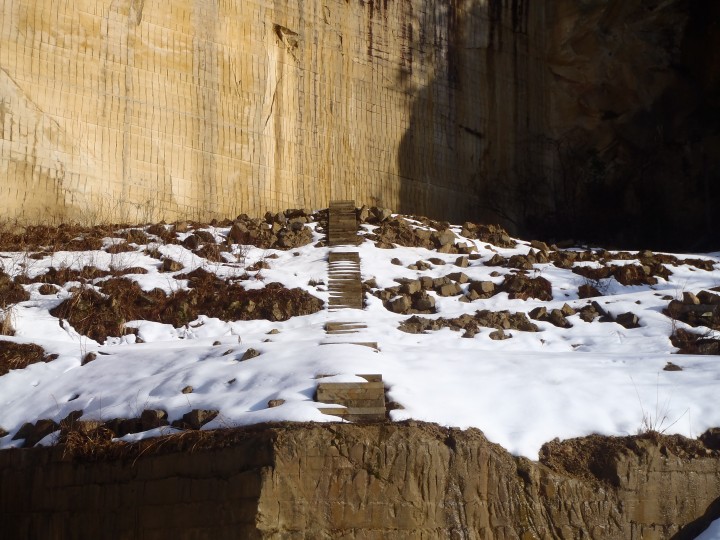Scottish Art News
Latest news
Magazine
News & Press
Publications
Julie Brook: What Is It That Will Last
By Susan Mansfield, 14.07.2023
.jpg)
Julie Brook is talking about her latest piece of sculpture, ‘Out of the Ground, A Thread of Air’, recently unveiled in the grounds of Holker Hall in Cumbria: “Imagine an enormous lorry from outer space dropped a big pile of Lakeland stone on this sloping ground - stones that weigh three, four, five tons, bigger than us - and I built a set of steps through it…”
And she recounts how, on opening day, the guests explored it. Children played on the steps; her 87-year-old father with his walking stick climbed carefully to the top. Brook watched, delighted. For an artist who has worked mainly in the remotest places where visitors are few - a peninsula on the west side of Lewis inaccessible by road, a stone quarry in Japan, a dry river the Namib desert - this was “a revelation”.
 'Firestacks Autumn', image courtesy of the artist
'Firestacks Autumn', image courtesy of the artist
“I have a very deep desire to share with people,” she says. “The solitary side of my practice, the wild side, is to understand what the work is, it’s not because I don’t want to be near people. To share the work is really exciting. Duchamp said a work of art is complete when it finds its audience. It might be one viewer or a multitude of viewers, but they are what makes it complete.”
Brook, who lives on Skye, has been making land art for 30 years, sculptural constructions often built with her own hands: a section of Namibian riverbank built into a perfect curve, a circular stone wall in the Hebrides with a precise opening which captures the midwinter sun. She’s no stranger to lonely places, long hikes, hostile weather.
She describes the work as “the unseen made visible”, allowing us to glimpse elemental forces: gravity, time, light. When I ask about the artists she most closely identifies with, she mentions the Scottish artist Katie Paterson, whose work explores the dimensions of time and deep space in ways that feel graspable. The boulders at Holker Hall, for example, are 450 million years old. Stop and think on that.
Exhibitions of Brook’s work in the UK are rare. This summer brings not only the unveiling of the Holker Hall commission but an exhibition at Abbot Hall near Kendal, What Is It That Will Last, also organised by Lakeland Arts, which looks back on the last ten years of her practice, accompanied by a new monograph of the same name.
Although the sculptures are scattered around the world, she emphasises that the work in the show is more than documentation. “It’s all the work. You’re going to experience a work in a very distilled way in a film that you can’t possibly experience in real life. The drawings are the quietest work but they have such material presence, they’re usually made in reflection on the sculptural works. Each validates the other, I don’t think you’re robbed of an experience by not seeing the actual piece.”
.jpg) What is it that will last, Abbot Hall, Lakeland Arts, image credit Robin Zahler
What is it that will last, Abbot Hall, Lakeland Arts, image credit Robin Zahler
Brook made her first land art in the early 1990s while camping alone for six months on the uninhabited west side of Jura, swimming in the sea, cooking on driftwood fires. She built a fire stack - a circular construction of stones - at low tide, filled it with driftwood and set it alight. The tide quenched the flames and, in time, dispersed the rocks. She was the only witness.
It established a way of making work which was monumental but also fragile. “In a way, the work is trying to answer that question: What is it that will last? Although it’s not a question any of us can answer directly. I’m excited by making work that has a greater degree of longevity than some of those early pieces, but they still quiver with a sense of being and non-being.
“‘Ascending’ (a winding staircase built in a quarry in Komatsu, Japan) looks like it’s been there forever, but if there was a rock fall it would be buried. Even the Holker Hall work, we could dismantle it in a day. I think that lies at the heart of the work.”
In the years that followed Jura, she worked for long periods on the uninhabited Hebridean island of Mingulay, until too many day visitors forced her to seek solitude further afield, exploring the Libyan desert with Tuareg guides, and working on dry riverbeds and quarries in Namibia. In 2015, she visited Japan for the first time and has made two major works there.
 Winter Wall, image courtesy of the artist
Winter Wall, image courtesy of the artist
She describes herself as “a maker”. “I don’t start with an idea that I then realise, I discover what the work is through the making. The work is at its best because I don’t know, can’t guarantee, what it will be. I wing it, I work out a method as I go along. It’s all questioning and learning.”
It’s only with hindsight that she sees clearly the links between the pieces: how ‘Divided Block’ in Namibia, which captures the midday sun, is in conversation with ‘Winter Wall’, a circular stone construction in Aird Mhór, Lewis, which captures the sun in midwinter; how the steps in ‘Ascending’ have a relationship with ‘Surrag Path’, a 34-metre long stepped path over a rockfall in Aird Mhór, which Brook hopes to finish this summer. When we speak, she is waiting on updates on how the sun is falling on a new work in Carrara, Italy.
However, she says joyfully that ‘Out of the Ground, A Thread of Air’, was as challenging as any of them, despite being made closer to home, closer to habitation. “The process of not knowing, unfolding, discovering was as much with this work as if I’m roaming around a river bank in Namibia or a Japanese quarry. It felt just as elusive, engaging and demanding, as experimental as any of my work.
“So there something very beautiful about seeing it with people walking up and down it. I hope it’s the beginning of a new strand in my work, where I might be invited to work in different places that have a natural public.”
 'Ascending', image courtesy of the artist
'Ascending', image courtesy of the artist
Julie Brook: What Is It That Will Last? is exhibited at Abbot Hall, Kendal, until 30th December and includes an exhibition of work from the Abbot Hall collection selected by Brook.
Out of the Ground, A Thread of Air is in the deer park at Holker Hall, Cark, Grange-Over-Sands. See www.lakelandarts.org.uk.
What Is It That Will Last? Land and Tidal Art of Julie Brook is published by Lund Humphries, price £39.95




